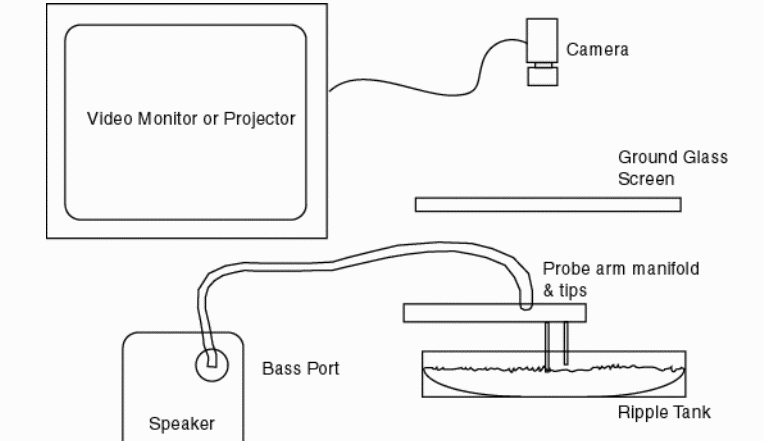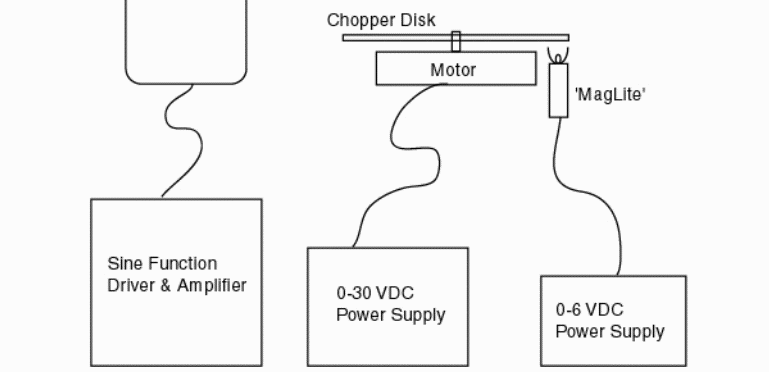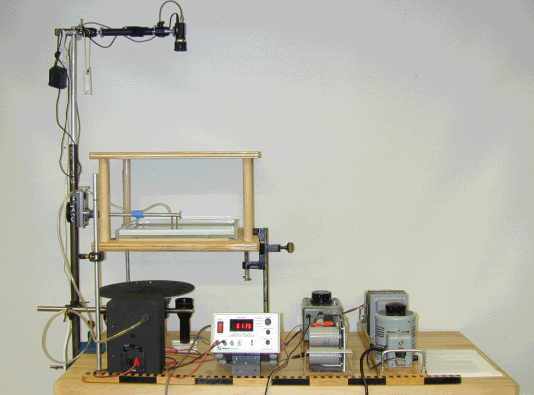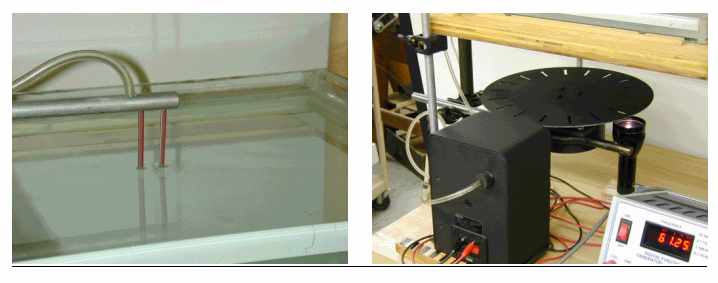

Advanced Laboratory / Lecture Demonstration Apparatus
Apparatus Title: Pneumatic Ripple Tank
Abstract: Using apparatus commonly available in a Demo Lab a very serviceable ripple tank is constructed which has very little distortion, a wide frequency range and the ability to strobe the wave forms for more careful observation, no mirrors are used, and it adapts easily to a video monitor or a projector.



Description: A function generator feeds a sine wave to the speaker. The speaker bass port is coupled to the probe arm & tip by a plastic hose and rubber stopper. The probe tips just interface with the water surface in the tank. The pressure variation of the speaker bass port coupled to the probe tip causes the water in the tip to oscillate in sympathy, thus propagating a nicely defined wave. This wave is then imaged by a standard 'MagLite' which in our case is modified to accept a remote power supply. The 'MagLite' is nearly a point source of light which is strobed by a rotating chopper wheel that is driven by a variable DC power supply. The strobed image is displayed on a ground glass screen above the tank. The screen is then imaged by a camera & ported to a monitor or a video projector. The driven frequency can be varied from 20 Hz to ~100 Hz. This range allows a number of interesting phenomena to be explored. The strobed waves can be adjusted to move or become stationary depending on what you would like to view. Both the driving frequency and the strobe rate can be varied to produce optimum results for a given probe tip.
Equipment Specifics: This version of the traditional ripple tank utilizes both a mechanical strobe (very cheap & easy to build) and a pneumatic drive scheme that has the ability to drive undistorted waves from a low frequency to a relatively high frequency. The double point source probe has tips that are slightly different lengths so that by raising or lowering the probe assembly you may demonstrate either single or double wave sources without changing probes. The Pasco function generator drives a cast metal housing 'Radio Shack' speaker. These speakers have a bass reflex/breathing port on the back and this is utilized to drive the ripple tank probes. A single hole stopper with a plastic hose attached connects the bass port and the probe manifold. The bass port supplies the drive to produce ripples in the tank. The probe arm, manifold and tips are self constructed. We used ½" diameter aluminum rod drilled out on one end to fit the plastic hose and the probe tips made of hot drink stirring straws. The manifold end cap is just metal tape. The strobe assembly is constructed from an old scrap DC motor. We used fiberglass PC board material to machine the chopper blade. Our first version, however, used heavy card board which worked just fine. The motor is driven by a variable 0-30 VDC power supply. Just about anything will work, but the more stable it is, the better it will work. The light point source is a modified 4 C-cell 'MagLite'. Although the battery version works OK, we opted to drive the light with a power supply to eliminate battery consumption, and to allow some variation in the brightness of the illumination. The ground glass screen images the ripples from the tank & probe for the camera to capture. The camera then ports the image to a monitor or a video projector for display. The usual probe tips all work fine, single point, double point, plane, single slit, double slit, variable single slit, depth variation barriers, flat and round barriers. Although this version of the ripple tank exploits some more expensive technology, the basic apparatus can be constructed simply & cheaply using equipment normally available in a Demo Lab and by constructing and scavenging the rest. The camera and monitor would not be necessary for small classes as a small number of students may view the ground glass image screen directly. The ripple tank is constructed of ~13" square plate glass with acrylic sides glued on w/ Silicone Aquarium sealant. The periphery of the interior of the tank uses sloped floor inserts to minimize the reflected waves from the sides.

Equipment List